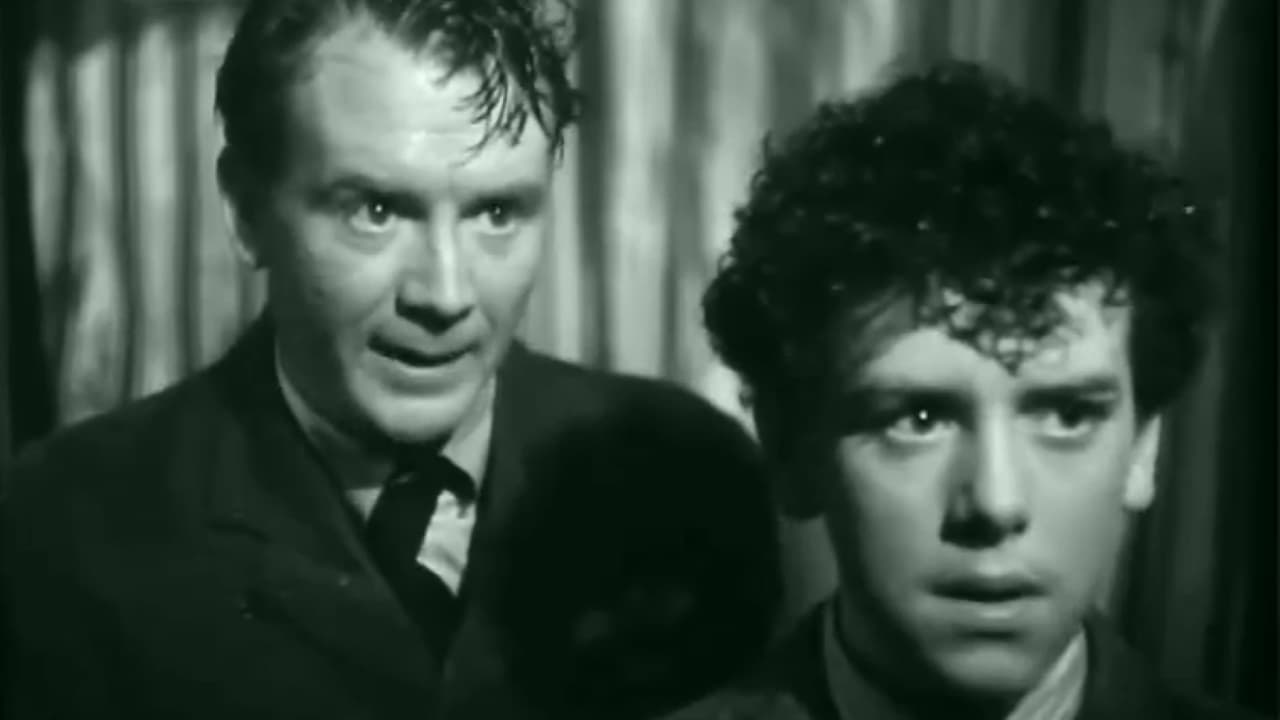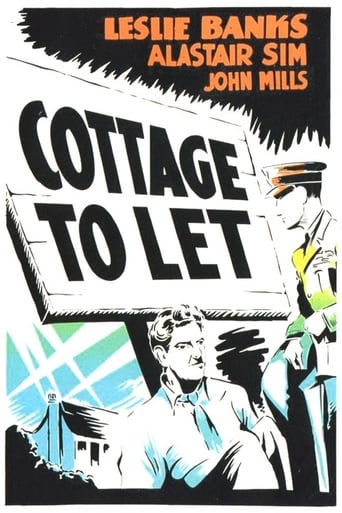

Better than you might expect from the British film industry at the height of the country's distress in 1941.It's a diverting and mostly comic mystery with a clotted plot. A cottage in rural Scotland is owned by the local aristocrat, Mrs. Barrington. She's a youngish woman with good intentions but with the insight of one of those vines whose leaves curl when you touch them."Pay no attention to the fact that you're such a nuisance," she tells one resident of the cottage. And, "I want you to do anything here you like except don't touch anything." And when Sims introduces himself, saying, "I'm Dimble," she puts a hand on his arm and replies, "Oh, I'm so sorry." This "cottage", by the way, is what most of us would call "a pretty big house." That's how it can be converted into a war time facility -- a hostel for young evacuees from London, a local hospital, a site for fund-raising bazaar, the laboratory of a bomb sight inventor.It appears that the inventor's secrets are somehow being conveyed to the Nazis. There are twists and turns in the plot, which I won't describe, except to say that there is one German agent and one double agent -- I think that's the term -- among the inhabitants.The film gets kinetic towards the end, with fist fights and shootings. It sheds its comic tone and turns into a thriller. That doesn't prevent one character from rolling a giant millstone over two armed enemies and commenting, "Two birds with one stone." Not to be taken seriously, and sometimes positively amusing.
... View MoreOthers have discussed the plot and acting in "Cottage to Let" (aka, "Bombsight Stolen"). To tell too much would take away from the enjoyment of this film. Some have said it has a slow start. But without such a background and build-up for so many characters, I think we'd be lost. At least one reviewer doubted the probability of such a scenario. I agree with the majority that this is an excellent war mystery and spy thriller. The cast is superb, with some big names of English theater and filmdom – John Mills, Alastair Sim, Michael Wilding, Leslie Banks, and others. And, it has an excellent supporting cast. Of course, this is a fiction story, as are so many of war-time. But as to the likelihood of something like it happening or not, one should consider some other factors. This movie was released in England on Sept. 6, 1941. The U.S. was not as yet in the war, even though most of Europe by then had been overrun by Nazi Germany. The official start of World War II was two years earlier. On Sept. 3, 1939, Britain and France had declared war on Germany after it invaded Poland. The Battle of Britain was waged from July 10 to Oct. 31, 1940, with Germany bombing London, major ports, and other large cities. Even after Britain won this battle for air superiority, Germany continued to bomb London and other cities. As this film noted, Londoners sent their children to country locations to keep them safe from the bombing raids. And, in fact, many British secret operations, including research and war design work were in locales across the country – away from the population and large military bases. Even after the U.S. entered the war and began sending troops to England in 1942, the Allies continued to disperse many of their war-time operations across the countryside. Many special projects were going on, none of which would be common knowledge to the public or reported in the press at the time. Only after the war did we learn about them. Movies have been made about some even decades later. All are interesting tales. Among the ones I've seen and enjoyed are: "Secret Flight" (aka, "School for Secrets") in 1946; "The Small Back Room" (aka, "Hour of Glory") in 1949; "The Dam Busters" in 1955; and "Enigma" in 2001.England had its share of German spies. British intelligence agencies broke up some German espionage rings working for the Abwehr, the German military intelligence service. And, Germany had tried to land agents by submarine in Scotland. No one knew or could imagine to what extent German agents or spies may be operating in England. So, this film was timely as well. I am curious though, about the late date of release of the film in the U.S. – May of 1943, Most of the British-made films during the war were released a year or more later in the U.S. One reviewer said that the Brits preferred American war films to those of the British film studios. I doubt there is any movie attendance or other data that would lend credence to such a statement. I'm sure the British public was drawn to all the war films that were being made at the time, regardless of the country source. No doubt, Englanders wanted to see some of the American movie stars they had come to know. At the same time, British studios were putting out some excellent films. Among them were "One of Our Aircraft is Missing," "Went the Day Well?," "In Which We Serve," "The Way Ahead," "49th Parallel," "Fires Were Started," "Convoy," "Freedom Radio," "The Day Will Dawn," "The Next of Kin," "The Foreman Went to France," "The Bells Go Down," "The Silver Fleet," and "Undercover." Many of the British post-war films also were excellent. I enjoy these films immensely, because they give us a look at the war from the eyes of British servicemen and public. Just as American films give others a view through Americans' eyes. The quality of the DVD I have with this film is rather poor. I hope a digitally mastered DVD will be produced one day soon.
... View MoreCottage to Let (1941)There are so many characters, so many tinges of British accent, and such a parade of turncoats and double agents it's difficult to quite follow everything here. But stick it out. Or, in the extreme case (which I admit taking) see it twice. It's "quite worth it, I dare say."A comedy on the surface, and quite funny all through, it's also a serious war movie, shot and released in the thick of World War II. The key theme is actually not the bomb sight design and the attempt by the government to protect its secret from spies. It's about loose lips. And looking for traitors among us.So, here at this cottage near where a top scientist is working on a secret weapon idea, there is a parade of suspicious characters, and I mean characters, including the redoubtable Alastair Sim. There is a nutty family running the place, a couple of love affairs in the air, a bunch of secret messages sent by various messengers. I count rough twelve characters who matter, and if some are very minor, they are critical in some small way to the outcome. Allegiances are everything.What makes the movie actually remarkable is that it holds to together so well. And it has a tight economy to the editing, and a fluidity to the filming, that keeps it really going. For some reason the lighting in the first half, and the interior scenes in general, is bright and flat (no Warner Bros. influence here I guess) but then there are some scenes later that are extraordinary in their dramatic atmosphere.In fact, there are some ideas that prefigure famous later ones, like the auction that is interrupted by spies and good guys by bidding incorrectly, stolen by Hitchcock in "North by Northwest." Or even the ending which is a slim version of the mirror shootout by Welles in "Lady from Shanghai." It's quite an exciting finish (never mind the goofy millstone moment, which you'll see). Anthony Asquith, the director, went on to make some mainstays of post-war British cinema, and that's yet another reason to appreciate this, as a precursor to his own work. But it also reveals a real intelligence for the movies. Evident and appreciated.In the big view, it isn't the plot, which is necessarily contrived to give a message to the nation, but the many pieces, and the writing and acting in those pieces, that make the movie really strong. The one version out there (streaming on Netflix) is a weak print (and there is no DVD release, apparently) so the sound and even the richness of the visuals will hamper a good appreciation. Even so, give it a look. Alertly.
... View More"Cottage to let" borrows heavily from the works of such popular British novelists of the 1930s as John Buchan,Dornford Yates and "Sapper".Kidnapped scientists,plucky schoolboys,cold -eyed detectives,dastardly German spies and pretty girls with summer dresses and wide-brimmed hats filled their pages.Now considered "Fascist",racist","imperialist"and probably several other "ists" I've never heard of,in more sensible times they were thought of as "good reads",nothing more,nothing less. In the movie the inventor of a secret bombsight is kidnapped by dastardly German spies and saved by the intervention of a plucky schoolboy and a cold - eyed detective. There is a splendidly Hitchcockian Auction scene where Mr John Mills as an injured RAF pilot picks up a warming pan by the handle and asks "What's this - a banjolele?"thus encapsulating in one word the whole era. Mr Alistair Sim is a sardonic Scottish detective,Miss Jeanne de Casalis (on the wireless as Mrs Shufflewick/Pennyfeather) splendidly dotty as the spooneristic posh lady. Young master George Cole is a role model for schoolboys carving Spitfires from bits of firewood during the blackout. Thoroughly enjoyable wartime entertainment at the expense of the dastardly Germans(sorry,our European partners - oops!I now await the midnight knock on the door)
... View More